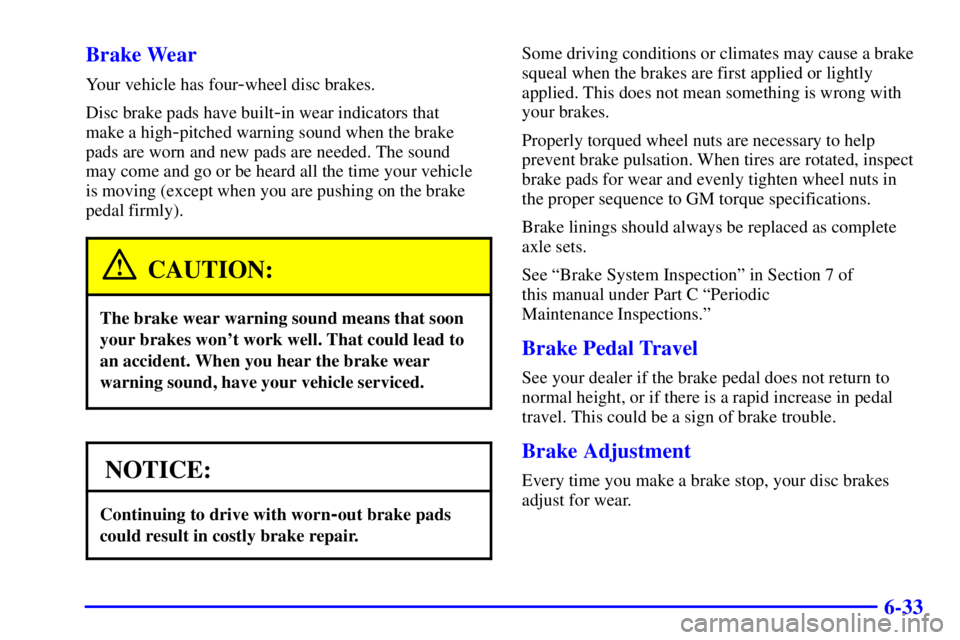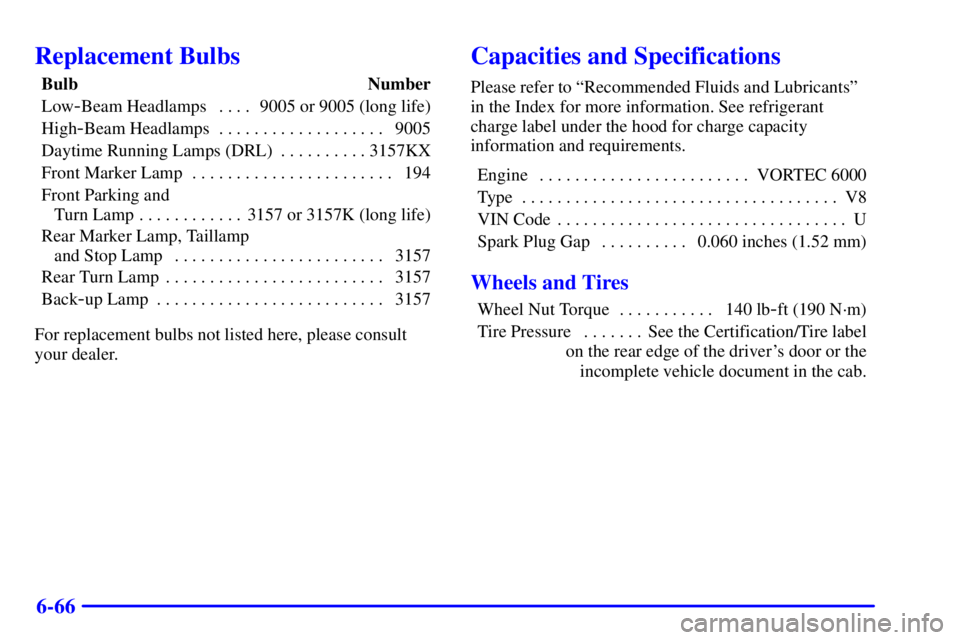Page 282 of 394
5-28
7. Tighten the nuts firmly in
a crisscross sequence as
shown by turning the
wheel wrench clockwise.
CAUTION:
Incorrect wheel nuts or improperly tightened
wheel nuts can cause the wheel to become loose
and even come off. This could lead to an accident.
Be sure to use the correct wheel nuts. If you have
to replace them, be sure to get new GM original
equipment wheel nuts.
Stop somewhere as soon as you can and have
the nuts tightened with a torque wrench
to 140 lb
-ft (190 N´m).
NOTICE:
Improperly tightened wheel nuts can lead to
brake pulsation and rotor damage. To avoid
expensive brake repairs, evenly tighten the wheel
nuts in the proper sequence and to the proper
torque specification.
When you reinstall the full-size wheel and tire, you
must also reinstall the center cap. Place the cap on
the wheel and tap it into place until it seats flush with
the wheel.
Page 321 of 394

6-33 Brake Wear
Your vehicle has four-wheel disc brakes.
Disc brake pads have built
-in wear indicators that
make a high
-pitched warning sound when the brake
pads are worn and new pads are needed. The sound
may come and go or be heard all the time your vehicle
is moving (except when you are pushing on the brake
pedal firmly).
CAUTION:
The brake wear warning sound means that soon
your brakes won't work well. That could lead to
an accident. When you hear the brake wear
warning sound, have your vehicle serviced.
NOTICE:
Continuing to drive with worn-out brake pads
could result in costly brake repair.
Some driving conditions or climates may cause a brake
squeal when the brakes are first applied or lightly
applied. This does not mean something is wrong with
your brakes.
Properly torqued wheel nuts are necessary to help
prevent brake pulsation. When tires are rotated, inspect
brake pads for wear and evenly tighten wheel nuts in
the proper sequence to GM torque specifications.
Brake linings should always be replaced as complete
axle sets.
See ªBrake System Inspectionº in Section 7 of
this manual under Part C ªPeriodic
Maintenance Inspections.º
Brake Pedal Travel
See your dealer if the brake pedal does not return to
normal height, or if there is a rapid increase in pedal
travel. This could be a sign of brake trouble.
Brake Adjustment
Every time you make a brake stop, your disc brakes
adjust for wear.
Page 330 of 394

6-42 Tire Inspection and Rotation
Tires should be rotated every 6,000 to 8,000 miles
(10 000 to 13 000 km). Any time you notice unusual
wear, rotate your tires as soon as possible and check
wheel alignment. Also check for damaged tires or
wheels. See ªWhen It's Time for New Tiresº and
ªWheel Replacementº later in this section for more
information. Make sure the spare tire is stored securely.
Push, pull, and then try to rotate or turn the tire. If it
moves, use the wheel wrench to tighten the cable. See
ªStoring a Flat or Spare Tire and Toolsº in the Index.
The purpose of regular rotation is to achieve more
uniform wear for all tires on the vehicle. The first
rotation is the most important. See ªScheduled
Maintenance Servicesº in the Index for scheduled
rotation intervals.
When rotating your tires, always use the correct rotation
pattern shown here. Don't include the spare tire in your
tire rotation.
After the tires have been rotated, adjust the front
and rear inflation pressures as shown on the
Certification/Tire label. Make certain that all wheel
nuts are properly tightened. See ªWheel Nut Torqueº in
the Index.
Page 354 of 394

6-66
Replacement Bulbs
Bulb Number
Low
-Beam Headlamps 9005 or 9005 (long life). . . .
High
-Beam Headlamps 9005. . . . . . . . . . . . . . . . . . .
Daytime Running Lamps (DRL) 3157KX. . . . . . . . . .
Front Marker Lamp 194. . . . . . . . . . . . . . . . . . . . . . .
Front Parking and
Turn Lamp 3157 or 3157K (long life). . . . . . . . . . . .
Rear Marker Lamp, Taillamp
and Stop Lamp 3157. . . . . . . . . . . . . . . . . . . . . . . .
Rear Turn Lamp 3157. . . . . . . . . . . . . . . . . . . . . . . . .
Back
-up Lamp 3157. . . . . . . . . . . . . . . . . . . . . . . . . .
For replacement bulbs not listed here, please consult
your dealer.
Capacities and Specifications
Please refer to ªRecommended Fluids and Lubricantsº
in the Index for more information. See refrigerant
charge label under the hood for charge capacity
information and requirements.
Engine VORTEC 6000. . . . . . . . . . . . . . . . . . . . . . . .
Type V8. . . . . . . . . . . . . . . . . . . . . . . . . . . . . . . . . . . .
VIN Code U. . . . . . . . . . . . . . . . . . . . . . . . . . . . . . . . .
Spark Plug Gap 0.060 inches (1.52 mm). . . . . . . . . .
Wheels and Tires
Wheel Nut Torque 140 lb-ft (190 N´m) . . . . . . . . . . .
Tire Pressure See the Certification/Tire label. . . . . . .
on the rear edge of the driver's door or the
incomplete vehicle document in the cab.